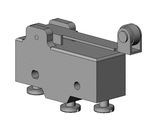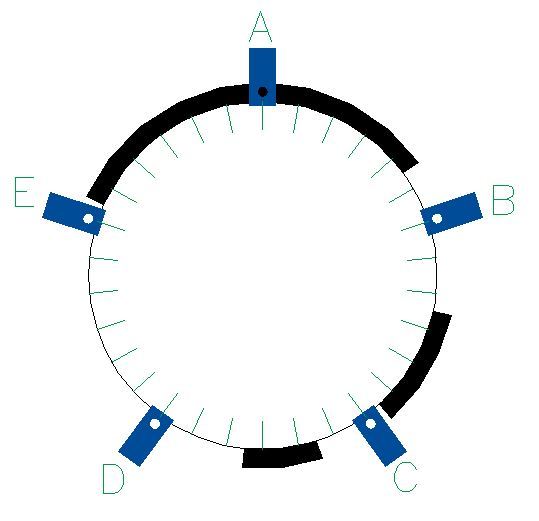jdunfee5
Mechanical
- Nov 22, 2013
- 33
I don't have any experience designing this type of cam system, an am wondering if I may be wanting to misuse this type of micro switch.

It happens to be a McMaster 7539K5, but I am asking about this general type of switch, rather than this specific model.
My application is for a fairly large machine that I want the user to be able to position at 45Deg increments, and also be able to disengage a clutch, so he can move the load manually. Because of space constraints and other issues, I am considering "rolling my own" rather than purchasing an off-the-shelf absolute encoder. My current design is to use a Gray-Code type of absolute positioning system, based on a 1994 design by Bruce Spedding. He came up with a way to use a single track, and multiple sensors to encode the position. Here is an image of the concept.

It uses 5 sensors, which will provide 30 positions.
In my case, I am hoping to attach a 6" dia encoder wheel to the output shaft of my gearmotor, and use the snap-action roller switch I showed at the beginning of my post. However, I wonder if this type of roller system is really designed to be used as a cam follower. My encoder will be rotating no more than 2 rpm, and will rotate both ways.
While I don't need high precision (+/- 1 deg is sufficient), I am concerned about how to get these switches properly located, and most important, set so that they trigger at the same max diameter on my cam. The roller is 3/8" Dia, and I obviously need to provide a proper ramp-in/out to the peak of the cam point. Of course, the mounting holes can have slots, but ideally I would want to just have accurately located holes to position the switches, so I don't have to spend as much effort adjusting the switches.
I realize there are other types of sensors, but I would prefer the mechanical switches for several reasons.
Are these types of switches commonly used in bi-directional cam following situations?
-Joe

It happens to be a McMaster 7539K5, but I am asking about this general type of switch, rather than this specific model.
My application is for a fairly large machine that I want the user to be able to position at 45Deg increments, and also be able to disengage a clutch, so he can move the load manually. Because of space constraints and other issues, I am considering "rolling my own" rather than purchasing an off-the-shelf absolute encoder. My current design is to use a Gray-Code type of absolute positioning system, based on a 1994 design by Bruce Spedding. He came up with a way to use a single track, and multiple sensors to encode the position. Here is an image of the concept.

It uses 5 sensors, which will provide 30 positions.
In my case, I am hoping to attach a 6" dia encoder wheel to the output shaft of my gearmotor, and use the snap-action roller switch I showed at the beginning of my post. However, I wonder if this type of roller system is really designed to be used as a cam follower. My encoder will be rotating no more than 2 rpm, and will rotate both ways.
While I don't need high precision (+/- 1 deg is sufficient), I am concerned about how to get these switches properly located, and most important, set so that they trigger at the same max diameter on my cam. The roller is 3/8" Dia, and I obviously need to provide a proper ramp-in/out to the peak of the cam point. Of course, the mounting holes can have slots, but ideally I would want to just have accurately located holes to position the switches, so I don't have to spend as much effort adjusting the switches.
I realize there are other types of sensors, but I would prefer the mechanical switches for several reasons.
Are these types of switches commonly used in bi-directional cam following situations?
-Joe
